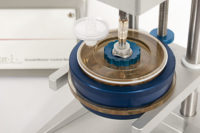Automotive testing applications present a diverse set of challenges to the designers of test systems, and the need for ever-more powerful and user-friendly test stands continues to grow as vehicle systems become more complex and more is understood about what actually occurs in real world conditions. To produce the desired results, test platforms need a controller that provides very stable closed-loop control, which is able to apply complex testing scenarios precisely, while being highly adaptable to new testing challenges.
Automotive component and subsystem suppliers are often faced with the dilemma that the mechanical aspects of an existing test system may be sound, but the control system may have become obsolete due to its use of an old, unsupported operating system or the lack of modern features and connectivity. The problems are exacerbated if the test stand was moved from one plant to another in its history. After such shakeups, operators and maintenance people may no longer be able to get it to work effectively. “When we get called in to do a test retrofit, we’re often looking at a 25 year old machine that’s mechanically sound, but limited by the electronics,” said Kevin Kretschmann, principal at test system manufacturer Innkeeper LLC of Livonia, Michigan.
Besides suffering from the effects of age on control system functionality, older test systems may not have the performance or flexibility to tackle new challenges. “Often, companies develop a unique test setup for each individual application, and the controls won’t let it be adapted to test new products,” said Kevin Kretschmann. Each Innkeeper InnControl system uses readily-available components selected to conform to the individual application intent as well as to add control or data acquisition capability.
Whether a retrofit or a brand new test system, Innkeeper bases its automotive test controls on two key elements: an electro-hydraulic motion controller to deliver real-world stresses, and a PC with a standardized user interface that can be used to set up and control a wide range of automotive testing applications and gather test data.
“We use no proprietary components,” said Kevin Kretschmann. “All controller electronics, PCs, power sources, amplifiers and current converters are readily available, off-the-shelf components. We select our components to best serve the requirement at hand and ones that have a good reputation for precision and durability.” The test machine that Innkeeper developed for heat exchanger applications (Figure 1) uses a servo hydraulic cylinder acting like a syringe to inject high frequency pressure pulses into the test specimen. In this manner, the machine can accurately reproduce the pressure fluctuations that occur under actual vehicle conditions. The cylinder is operated via a high performance servo valve which is in turn driven by an electro-hydraulic motion controller.
Controlling the Motion
Innkeeper uses RMC75 (1-2 axes) or RMC151 (2-8 axes) motion controllers (Figure 2), manufactured by Delta Computer Systems Inc. of Battle Ground, Washington. “Delta controllers are readily available and are very easy to program,” said Kretschmann, “and the company delivers excellent technical support. They are also committed to providing support for their older hardware platforms, which is a big issue in the testing industry.”
The RMC connects to the PC via Ethernet and performs all of the actual closed loop control, limit checking and cycle counting. It holds the custom test profiles, allowing the PC to stay out of the loop and focus on monitoring/acquiring data.
Innkeeper’s InnControl user interface (UI) software, running on the PC, handshakes with the RMC to allow parametric manipulation of the key variables related to dynamic test performance and data acquisition (see Figure 3). The UI has been standardized for all typical functions of a structural test controller and offers the user full control of peripheral equipment (hydraulics, lights, cameras for example), creating a standardized platform in which to set up tests (varying frequency cycles, amplitudes, etc.) and performance parameters (e.g., PID gains, calibration info, amplitude control, limit levels) for transfer into the RMC.
“Delta’s RMC series controllers provide us with great control on all tests ranging from quasi-static through 50 Hz operation, with a loop update rate between 1000-4000 Hz and supporting data acquisition of all signals up to 1000 samples per second per channel,” said Kretschmann. “We can build and the accurately control any waveform or combination of waves within this range.”
Example Application: Testing Transmission Coolers for Heavy Trucks
One of Innkeeper’s customers, a manufacturer of heat exchanger systems for use in OEM vehicles, needed to develop a pressure cycle test for a transmission cooler that did not currently exist. Typical pressure cycle test rigs would not duplicate the waveshaping or frequency requirements that they were faced with. For high performance, flexible testing of this sort a hardware-based, closed loop hydraulic servo control system would be required. Innkeeper was tasked with designing and building a pressure cycle durability machine that would control pressure and temperature within the specimen, with performance from 0 – 30 Hertz and dynamic pressure pulses from 0 to 750 psi, provide a full array of data acquisition options (e.g., Trend Monitoring, Triggered Event Data, Good vs Bad Cycle counting.)
The company suspected that the durability testing currently available would not adequately identify field conditions seen in early prototypes. In short, there was no current way to quickly identify failure modes or validate design changes. Innkeeper’s engineer evaluated the specification and determined that the best solution required a closed loop servo-hydraulic control system.
Solving the Transmission Cooler Test Problem
To ensure that the new test system was applying realistic stresses, the manufacturer recorded the pressures that occur in a real engine braking session. They then generated a waveform that simulated a combination of pump pressure changes with superimposed clutch / valve shudder seen in some heavy duty transmission applications. It was immediately evident that pressure oscillations during these real life events could not be simulated with the test equipment currently available. The transmission cooler was being subjected to real life pressures and forces that were not being measured in the testing process. As a result, the field oscillations were shortening the useful life of the coolers. The tests that the manufacturer was running previously could not duplicate these complex oscillations and hence created a false sense of quality since they didn’t cause the same failure rate as the parts exhibited in the field.
Using the real-world data as a reference, the Innkeeper engineer built a flexible control program within the Delta RMC that allows for any number of different pressure cycles to be accurately performed. The customer was able to define their test from the User Interface and download it into the RMC for operation. The desired pressure pattern could then easily be entered into the machine, which allowed the field results to be accurately duplicated in the laboratory. In the main test pattern, the Delta controller was able to ramp pressure up from 0 psi at a fixed velocity, then immediately translate into a high frequency pressure controlled sine wave for several seconds before ramping pressure back down to 0 psi at a fixed rate (see Figure 4). Then the process was repeated three million times. Simpler tests are also run with cyclic pressure and frequency combinations ranging between 0-100psi at1 Hz, 0-500psi at 5 Hz, 0-200psi at 30 Hz, with each test accurate to within a few psi.
“Though we’re purely controlling pressure in this system during the actual test cycle, we use cylinder position control to make sure that the specimen is completely void of air before starting a test cycle,” said Kevin Kretschmann. “We also use the displacement information from a cylinder position sensor to position the piston before starting the compression cycle, and we monitor cylinder displacement as a safety mechanism in order to tell, to within one fluid ounce, if the oil is leaking anywhere. Other sensor inputs to the Delta controller include temperature sensors and strain sensors to provide additional information on system status as tests are underway.
Hydraulic control applications such as this are well within the Delta motion controller’s capability. Test systems that are designed for a special purpose might cost upwards of $1 million, and using the programmable Delta motion controller as a key system component enables Innkeeper to offer precision automotive testing capability for a fraction of the price.
“The RMC in combination with our UI allows for a complete and flexible test site controller,” said Kretschmann. “When we update an older test system, we can give the plant operators the same functionality or more at a whole lot lower price.”





